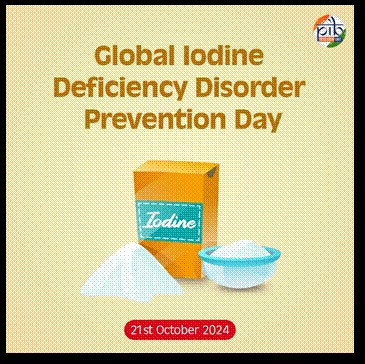
World Iodine Deficiency Day: Raising Awareness for Global Health
Every year on October 21, World Iodine Deficiency Day, also known as Global Iodine Deficiency Disorders Prevention Day, is observed to highlight the critical role iodine plays in human health. The day serves as a reminder of the importance of iodine in daily nutrition and the serious consequences that arise from iodine deficiency, particularly for vulnerable populations such as pregnant women, infants, and children. This global event calls attention to efforts in preventing iodine deficiency disorders (IDD), a leading cause of preventable intellectual disability worldwide.
Iodine is an essential element for the production of thyroid hormones, thyroxine (T4) and triiodothyronine (T3), which regulate metabolism and are crucial for growth, development, and brain function. Found in foods like seafood, dairy, and most commonly in iodized salt, iodine is absorbed by the body primarily in the form of iodide. Without sufficient iodine, the body cannot produce adequate amounts of thyroid hormones, leading to a variety of health problems. Hypothyroidism, which often manifests with the development of a goitre (enlarged thyroid gland), is one of the earliest signs of iodine deficiency.
Pregnant women are particularly susceptible to iodine deficiency, which can have severe consequences for both mother and child. Insufficient iodine during pregnancy can lead to miscarriages, stillbirths, and neurodevelopmental deficits in the fetus, including cretinism, a condition marked by intellectual disability and stunted growth.
For infants and children, iodine deficiency can impair cognitive development, resulting in lower IQ scores and an increased risk of attention disorders like ADHD. Even adults are affected by iodine deficiency, with consequences ranging from reduced mental function and work productivity to the development of goitre and an elevated risk of thyroid cancer.
In India, iodine deficiency was identified as a serious public health concern in the mid-20th century, leading to the establishment of the National Goitre Control Programme (NGCP) in 1962.
This initiative was a major milestone in the country’s effort to address iodine deficiency, which had been linked to widespread health issues such as cretinism, mental and physical retardation, and high rates of stillbirth. By 1992, the program was expanded and renamed the National Iodine Deficiency Disorders Control Programme (NIDDCP), reflecting its broadened scope in tackling a wider range of iodine-related conditions across the nation.
The NIDDCP aimed to reduce the prevalence of IDD in India to below 5% and ensure universal access to iodized salt. To achieve these goals, the program focused on key interventions, including conducting district-level surveys to assess IDD prevalence, promoting the replacement of common salt with iodized salt, monitoring iodine levels through laboratory testing, and launching public health campaigns to educate the population about the importance of iodine. A major breakthrough came in 1984, when India mandated the iodization of all edible salt.
This initiative was rolled out in phases beginning in 1986, and by 1992, India was fully producing iodized salt, with current production reaching 65 lakh metric tonnes annually—enough to meet the dietary needs of its entire population.
The success of NIDDCP is evident in the significant reduction of IDD across the country. The total goitre rate, a key indicator of iodine deficiency, has decreased substantially, and regulatory measures such as the Food Safety and Standards (Prohibition and Restriction on Sales) Regulation, 2011, have ensured that only iodized salt is sold for direct human consumption. Additionally, a network of monitoring laboratories has been established, including a National Reference Laboratory at the National Centre for Disease Control (NCDC) in Delhi, along with regional labs, to oversee the quality of iodized salt and track iodine levels in the population.
Global efforts to address iodine deficiency have also been impactful, with organizations like the World Health Organization (WHO) and UNICEF leading the charge. Since 1993, these organizations have advocated for universal salt iodization as a strategy to combat IDD.
Today, more than 120 countries have adopted iodization programs, and these initiatives have significantly reduced the global burden of iodine deficiency. However, the problem persists, with an estimated 1.88 billion people—almost 30% of school-aged children—still at risk of insufficient iodine intake worldwide.
World Iodine Deficiency Day serves as a reminder of the progress made in combating iodine deficiency disorders but also underscores the need for continued vigilance. In countries like India, where national programs have made substantial advances, maintaining public awareness and monitoring iodine levels remain essential.
Globally, the efforts of organizations like WHO and UNICEF must be sustained to ensure that all populations, particularly those in low- and middle-income countries, have access to adequately iodized salt and the health benefits it provides. By continuing these efforts, we can work toward a future where iodine deficiency disorders are eradicated, improving quality of life and health outcomes for millions of people worldwide.